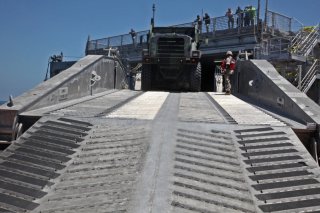The Navy's Ship-to-Shore Connector is a Technological Miracle
While the groundbreaking Ship-to-Shore Connectors may not look new, they are equipped with an array of new technologies.
The U.S. Navy is ramping up production of its groundbreaking Ship-to-Shore Connector (SSC). Capable of carrying Abrams tanks, the SSC is designed to transport Marines, vehicles, and weapons in support of an amphibious attack.
The new landing craft has been specifically ruggedized for harsh environmental and military conditions, Navy developers explained.
“It provides the capability to rapidly move assault forces within the littoral operational environment in support of the unified campaign plan missions,” Capt. Scot Searles told an audience at the 2022 Surface Navy Symposium. Searles added that “this ensures the joint force commander's ability to conduct amphibious operations, including movement over ice, mud, river swamps, rocks, boulders, [and] obstacles up to four feet high … it's a flying ship.”
While the new Ship-to-Shore Connectors may look like the Landing Craft Air Cushions (LCACs) that they are replacing, they are equipped with an array of new technologies, including advancements in corrosion resistance and the use of durable composite materials. The new SSCs also operate with a more powerful Rolls Royce engine that increases speed, propulsion and operational fuel efficiency, Searles explained. The new SSC Rolls Royce engines are the same as those that power the MV-22 Osprey aircraft.
Yet another impactful advantage of the SSC is its increased payload capacity, which allows it to transport a seventy-four-ton Abrams tank for amphibious attacks.
The Textron-built SSCs also incorporate automated flight controls and modernized engines, company officials said. Computer automation built into the SSC includes digital flight controls that are designed to replace the traditional yoke and pedals. Developers say the SSC’s computers will quickly calculate relevant details, such as wind speed and navigational information.
The new SSCs have also moved to a lower frequency for ship electronics in order to better synchronize ship systems with Navy common standards, Textron developers said. Along with these properties, the new craft reduces the number of gearboxes from eight to two.
As armored combat vehicles typically take a long time to deploy, they often need to be forward stationed. However, the innovations built into the SSC are intended to adapt to a new threat environment in which heavier vehicles might be needed to quickly deploy to reinforce an amphibious landing. Navy officials explained that the aging LCACs can only transport up to sixty tons, reach speeds of thirty-six knots, and travel 200 nautical miles.
Searles also explained that the Navy is conducting “control damage tests” on the new SSC to assess its survivability. The Navy has twenty-four SSCs on contract with Textron and plans to deliver four per year. “We think that’s achievable. We’ve had two deliveries each of the last two years and we have a nice full production line now,” Searles said.
Kris Osborn is the Defense Editor for the National Interest. Osborn previously served at the Pentagon as a Highly Qualified Expert with the Office of the Assistant Secretary of the Army—Acquisition, Logistics & Technology. Osborn has also worked as an anchor and on-air military specialist at national TV networks. He has appeared as a guest military expert on Fox News, MSNBC, The Military Channel, and The History Channel. He also has a Master's Degree in Comparative Literature from Columbia University.
Image: Reuters.

